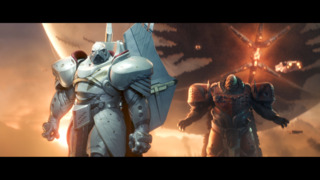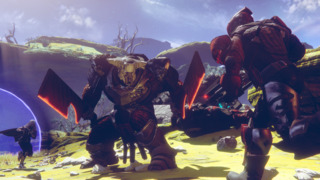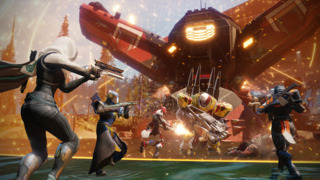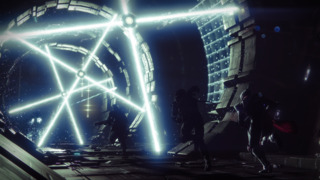The list of large and small ways Destiny 2 is a streamlined, better designed, and more rewarding game than its predecessor is probably a hundred lines long. To cut to the chase, this is a game that finally makes good--sometimes a little too good--on Bungie's big idea of blending its genre-leading console first-person shooting with a Diablo-style loot dispenser, and it's been a long time coming. Remember 2014, when the first Destiny's notoriously fractured storyline and aimless, unfulfilling endgame grind left a large portion of its player base feeling shortchanged? Bungie does. On both counts, it's clear in playing Destiny 2 that Bungie learned most of the right lessons from the turmoil of Destiny's debut, even as it feels like the studio also forgot some of what made Destiny unique along the way.

Destiny 2 certainly has a more coherent story than last time. The sequel turns the forgettable faction vendors from the first Destiny into living, breathing video game characters and casts them in a desperate fight for survival as a legion of particularly mean Cabal, the franchise's monstrous spacefaring version of the Roman Empire, shows up and kicks what's left of humanity out of its last refuge on Earth. These principal characters are scattered across the solar system as the Cabal busies itself stealing the god-like powers of the enigmatic giant space orb that makes Destiny possible, and you then spend a dozen-odd missions flying from moon to planetoid to capital spaceship and back, trying to recruit those faction vendors back into the fold so they can lead an assault on the Cabal occupation. In contrast to the nebulous mess of the original, Destiny 2's story is clearly presented and you never have to stop and scratch your head, wondering what you're doing and why. There are unique mission mechanics, fast-paced vehicle sequences, and a whole lot of enormity and spectacle that recall Bungie's best campaigns. It's epic and exciting and focused in a way the original Destiny wasn't.
At the same time, there's a distinct shift in tone from the first game. Where Destiny was austere to a fault, the sequel overcorrects with a cast that sometimes feels like it's made up entirely of comic relief (and not all of the jokes are very comical), and the plot turns on more trite video game clichés than I've come to expect from Bungie. The story revolves around a world-destroying super machine and a sneering one-note villain in a way that's a little too predictable, coming from a studio that's never really relied on things like mustache-twirling bad guys. Recall that the entire Halo series' long-running antagonist wasn't a single villain but a multi-species alien religious cult with a complex hierarchy and system of beliefs. The first Destiny struggled to even effectively explain who you were fighting against or what the stakes were, but I hoped for a little more than a vaguely generic bad guy who wants to blow everything up in the sequel.

For all the incoherence of its plot, Destiny managed to imply the outlines of a vastly grander world than what was taking place right in front of you. It was a world with numerous alien factions each with their own agendas, rituals, and social structures--even if you had to dig through digital trading cards on your phone to fully understand everything--all taking place against the crumbling interplanetary remains of humanity's most triumphant era. A couple of those alien factions feel like they're reduced to set dressing in Destiny 2, and with a few exceptions there's less interest in building intrigue around the mysteries of a fallen civilization. The first game struck a unique blend of tangible and mystical. Its combination of post-utopian science fiction and classical mythology created a specific atmosphere that fired the imagination, and its setting among our solar system's most familiar and yet unknowable locations served a function of wish fulfillment, as you rooted around the remains of a research collective on Venus or explored alien cathedrals hollowed out of the goddamn Moon. Destiny 2 makes a similar attempt, but comes up short. Of the game's four locations, one is essentially a glorified oil rig, and while another, Nessus, is technically a real planetoid way out in the far reaches, who had ever heard of it before this game? To some extent this is all a matter of taste; Destiny 2 trades breadth for focus, and that'll work better for some people, but it resulted in a less memorable experience for me. Bungie's storytelling has always been a little weird, but not much of Destiny 2 is as weird as the first game.
Having said all this, the conclusion of Destiny 2's campaign defied my expectations in some startling ways, and there's such an urgency to the last handful of missions and the world of Destiny is left so fundamentally revitalized after the last couple of hours that the ending did a little to relieve my relative disappointment with some of what had preceded it. Without getting too specific, the campaign leaves the world of Destiny in an exciting place, and sets up the franchise to deliver new stories in the future that are more in line with what I've come to expect from this series.
There's a good chance you'll actually want to stick around this time for those new stories to drop over the coming months and years. The single best thing I can say about Destiny 2 is that Bungie has finally found a way to fit all of the game's nuts and bolts together to create a loot shooter satisfying enough that the only reason to stop playing it is because you've run out of things to do. And there's a lot to do. In addition to the campaign, all the activities you expect from the first game return, from patrols and public events in the open world to three-player strikes, the competitive Crucible, and weekly rotations of ultra-hard Nightfall strikes and Trials of the Nine competitive matches. And then, of course, there's a post-game raid for six players, a grueling cooperative challenge that can take you a dozen hours to analyze, figure out, and actually defeat.

Sure, most of this stuff was featured in the first Destiny, but it's all been refreshed or improved here in significant ways. There are more types of public events now, and they all have optional heroic versions that are harder and yield more rewards (and are a challenge to unlock in their own right). Nightfalls now come with more inventive modifiers that dramatically change the way you play. The first game's Nightfalls merely increased various weapons' damage and forced you to restart the entire mission if your team wiped, leading you to play incredibly cautiously (or in my case, frequently not play at all). The new Nightfalls feature tight timers and rotating damage mechanics that require precise, coordinated, speedy play that's an exhilarating improvement on the plodding old version. The Crucible comes with a smattering of standard modes across multiple playlists, and while this sort of multiplayer with its player shields, high-flying jump jets, and all-powerful super abilities isn't for everyone, I've come to enjoy the smaller scale and more tactical nature of Destiny 2's multiplayer now that it's been reduced to four players. If nothing else, this makes it a lot easier to get a fireteam of three other people together to play with you, and a good fireteam with strong communication can really clean up in there.
The key to making Destiny 2's activities and character progression so much more seamless and rewarding than in the first game is in simplification. Bungie has thrown out all the esoteric nonsense from the first game, with its half-dozen different types of upgrade currencies and weird quest items and other concepts that some players understandably balked at. In place of all that, there's now a simple reputation system where each planet and each type of activity has a vendor associated with it, and anything you do on that planet or in that activity contributes to your reputation with that vendor. When the meter with a given vendor ticks over, you pick up another item package. Rinse and repeat as necessary. Whether you're running a ton of strikes, or playing Crucible endlessly, or hanging out with friends and casually popping off public events and looking for treasure chests in the European Dead Zone, you're earning rep that will translate into new gear sooner than later. And all of these activities are tied together with a challenge system that gives you even more goals to work for and results in even more gear on a daily basis, with a weekly set of "milestone" quests that guarantee you gear well above your level if you complete the requisite activities. The game has a way of making you feel like you're working toward three or four different goals at once. Where Destiny sometimes felt too stingy with its gear drops, especially in the endgame, you'll quickly have more loot in this game than you know what to do with.

Actually, that's the other thing that makes Destiny 2 work better: they upped the drop rates. A lot. You will not stop getting a steady stream of better gear right up till you're ready to tackle the endgame raid, and there are relatively easy ways to level beyond that. The elusive exotics--hand-crafted weapons and armor that were so rare in the first game Bungie added another item to increase your chances of seeing them--are now built-in quest rewards throughout the story and also drop at a startlingly fast pace. For the most part all this loot keeps the game humming along, and keeps the endorphines pumping steadily in your brain as you get new guns and armor at a steady clip. I can't believe I'm saying this, but at times it can instead feel like too much of a good thing, and I almost wished the game would pump the brakes a little. Some of the lower-level guns are quite fun to use, but during the early game you rarely use the same gun for more than an hour before you get something better and feel compelled to switch to the thing with the higher number. It doesn't always feel like a given loadout has time to breathe before you're shaking it up again.
The bigger problem with getting so much loot is that you can level right past some of the better content in Destiny 2 without realizing it. Bungie has included a new "adventure" category of missions scattered around each location, and these are well worth seeing. While the main campaign typically makes you feel like you just arrived at a new location before you're being whisked off to the next one, the adventure missions help to flesh out and develop the characters and goings-on in a specific place. Each one has unique voiceovers and little self-contained storylines, and many of them feature unique mechanics or take you to some really impressive-looking parts of each zone that you wouldn't necessarily run across otherwise. The problem is, the rewards for these missions are fixed and aren't especially valuable in light of all the other activities that yield gear much faster, so if you're doing a mix of Crucible, public events, and so forth along with the campaign, you can reach a point before you realize it where the adventures are no longer valuable from an upgrade perspective. It would have been nice to see these missions utilized in a way that feels more meaningful to your character progression, and I ended up solving this problem by, uh, starting a second character and making sure to step off the loot treadmill to stop and smell the roses once in a while. Though, if the arc of the first Destiny is any indication, there's a good chance Bungie will go in and find a way to draw more players into this sort of meaningful side content over time.
Destiny 2 adds a tremendous number of quality-of-life improvements that should be a huge relief for long-suffering fans of the first game. You can now travel directly from planet to planet, rather than having to sit through one loading screen to return to orbit, then another one to fly to a new location. Unidentified loot engrams now go into their own inventory bucket rather than cluttering up your gear slots, and in a why-didn't-they-think-of-this-before move, the game now takes all the gear you possess in your inventory and vault into account when it generates new loot for you, rather than forcing you to tediously equip your highest-value stuff every time you go to decode an engram. Public events now show up on zone maps complete with a little timer telling you exactly when they'll start. And clans, which were worse than useless in the first game, are now a brilliant way not just to organize activities with friendly players, but to collectively contribute to group goals. Clans level up based on everything their members do in the game, unlocking little buffs and bonuses along the way. And in perhaps the most player-friendly change in all of Destiny 2, every week that a single clan fireteam completes a tough challenge like a Nightfall, raid, or Trials run, every clan member gets a piece of high-value, rare loot. The new clan system is a brilliant way to get people together for pickup activities and so forth. It's entirely possible I've had more social interaction in two weeks of playing Destiny 2 than I've had in calendar 2017 to date, which I hope says more about what a good time this game is with friends than it does about me.

Perhaps the one mark on Destiny 2's record is its increased focus on microtransactions. The first game introduced paid cosmetic items and player emotes over time in a relatively inoffensive way, and that system returns here in an expanded capacity. There are way more and higher quality cosmetics than before, and you can actually earn a fair number of them for free just by playing the game (paying will only give you quite a few more of them faster). The one outrageous exception is the change to the shader system that previously let you dye all your gear the same color. On the upside, shaders can now be applied individually to each piece of armor, and also to every gun, sparrow, and ship in the game. On the downside, shaders are now single-use items that you'll need to grind to obtain more of... unless you pay real money to get them faster, and even then you may not get the ones you want. And this is in a game where you change gear constantly and will lose those shaders sooner than you'd like. It's a real shame to see Bungie regress a previously player-friendly customization system, seemingly in an effort to drive microtransactions.
It goes without saying that Destiny's core shooting remains among the absolute best available on a console, but it's worth noting that the game's three classes and their three subclasses have been redesigned from the ground up to give you more interesting and consistent gameplay options. In contrast to Destiny's confusing grid of ability bubbles, the subclass skill trees here are easily legible and are all split into two branches, each of which has a unifying theme. So if you want a gameplay style that revolves around getting aerial kills, or one that lets you recover health in multiple ways, or one that just lets you punch the hell out of everything, you can have that. The perks on a lot of exotic gear seem tailored to further enhance specific subclasses, and there's also a fairly clever (if slightly confusing) new gear mod system that lets you add even more buffs to weapon handling, ability recharge rates, and so forth on each piece of gear. You can even use gear mods to change out the damage type on elemental weapons. Speaking of weapons, the first game's primary/secondary/heavy system has given way to kinetic, energy, and power types. Now hand cannons and auto, scout, and pulse rifles can have elemental damage types and sit in both your first and second slots, letting you customize more thoroughly with weapon combinations you couldn't use before. Shotguns and sniper rifles now hang out in the power category along with rocket launchers and swords, which certainly makes them a less frequent annoyance in the Crucible, and the game seems to be more generous with power ammo in PVE activities, so you still get to use those weapons plenty there. Just about everything related to the combat in Destiny 2 feels more varied and thoughtful than it did in the first game.

It shouldn't be surprising to say the look and feel of Destiny 2 more than lives up to Bungie's considerable pedigree, but that doesn't diminish the sheer artistic accomplishment of the game. Even as I found some of the new planetary locations conceptually less interesting than those of the first Destiny, I also lost count of the times my jaw dropped open at some perfectly framed scene or elaborately lit tableau, especially in the raid and some of the strikes. There's an increase in both the size and detail of the game's environments over the first Destiny, probably owing to the focus on current console hardware this time around, and the second-to-last mission of the campaign in particular features some of the most breathtaking and larger-than-life imagery I can ever remember in a game. And while I sorely miss Marty O'Donnell's signature percussion and the game could use a few more french horns, the Destiny 2 score has grown on me considerably over a few dozen hours. There are some really memorable themes in here, and the inclusion of the Kronos Quartet gives a couple of dramatic scenes some real emotional oomph.
Like with any loot game, you'll eventually exhaust Destiny 2's content, but unlike the first Destiny, you'll likely feel a lot more satisfied when you do. The new raid, Leviathan, is much easier for new players to access in terms of gear requirements, and has an unexpected setting and some utterly wild visuals and moments, even though a couple of the encounters are infuriatingly inconsistent at the moment. Trials of the Nine has less stringent requirements than its incarnation in the first game as well, and if you play enough of it you might earn enough rep for an item or two even if you never manage to eke out seven consecutive wins. Bungie has also gotten better about communicating its roadmap for future content and is already teasing something called "Faction Rally" in the near future, and you can bet Iron Banner will worm its way back into the game some weekend soon. And this is all in advance of the first DLC pack coming in three months, which is rumored to contain an entire new planet to explore, provided you like this game enough to pay for more of it. That's the biggest success of this sequel: it's now good enough that you no longer need to make excuses about why you play so much Destiny. Destiny 2 may misstep in a couple of ways its predecessor didn't, but it also shores up its fundamentals so thoroughly that the future for Destiny fans looks bright indeed.